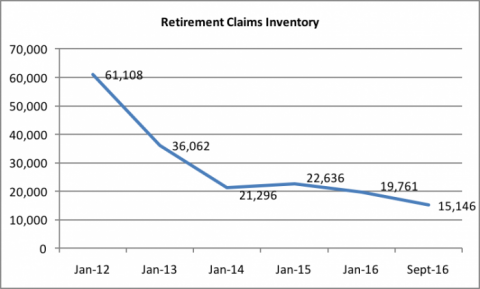- Home
- Agencies
- Department of Agriculture
- Department of Housing and Urban Development
- General Services Administration
- Department of Commerce
- Department of the Interior
- National Aeronautics and Space Administration
- Department of Defense
- Department of Justice
- National Science Foundation
- Department of Education
- Department of Labor
- Office of Personnel Management
- Department of Energy
- Department of State
- Small Business Administration
- Environmental Protection Agency
- Department of Transportation
- Social Security Administration
- Department of Health and Human Services
- Department of the Treasury
- U.S. Agency for International Development
- Department of Homeland Security
- Department of Veterans Affairs
- Goals
- Initiatives
- Programs
Retirement Claims Inventory Decreases by 75.2 Percent Since 2012
What is the Issue?
What’s the issue?
OPM is responsible for the administration of the Federal Retirement Program covering more than 2.7 million active employees, including the United States Postal Service, and nearly 2.6 million annuitants and survivors. Each year, OPM is responsible for processing more than 100,000 new requests for retirement. The timely issuance of full annuity payments to annuitants is critical for many retirees who depend on this income, and has been a long-standing challenge. In January 2012, the OPM retirement claims inventory had reached 61,108 claims.
What was the Intervention?
In January 2012, OPM released and began implementing core components of its Retirement Services Strategic Plan which includes delivering quality customer service; implementing productivity and process improvements; partnering with agencies to ensure that they are submitting complete and accurate retirement packages for quicker processing; and making progressive information technology improvements. OPM used Lean Six Sigma to streamline and standardize internal processes. OPM also partnered with the Defense Finance and Accounting Service (DFAS) and United States Postal Service (USPS) to help with claims processing, and coordinated biweekly meetings with USPS and the National Personnel Records Center to address common retirement processing issues. In addition, OPM has focused on both internal and external outreach efforts to improve processes.
How was performance management useful?
OPM made the receipt of timely, appropriate, transparent, seamless, and accurate retirement benefits a strategic goal, and made retirement services case processing an Agency Priority Goal for both the FY 2014-2015 and FY 2016-2017 goal cycles. As a result of elevating this goal to an APG, the claims inventory and the percent of retirement claims processed within 60 days were tracked and monitored monthly by the goal team members and reviewed every 4-8 weeks by agency leadership. The data helped leadership track the magnitude of the inventory and the impact of surges, and identify changes needed to bring the claims inventory to a steady state.
What was the impact?
During FY 2016, OPM processed 77.1 percent of retirement cases in 60 days or less. The average processing time for cases completed was 40 days for cases under 60 days, and 102 for cases over 60 days. Although the agency did not meet its target of processing 90 percent of cases in 60 days or less, it has made considerable strides in processing claims over time. In 2012, the average processing time for all cases completed was 173 days. By 2016, that processing time has been reduced to an average of 54 days for all cases completed. Since 2012, OPM reduced the claims inventory from 61,108 cases in January of 2012 to 15,146 at the end of FY 2016—a reduction of 75.2 percent. The decrease in inventory and processing time greatly improved customer service.





